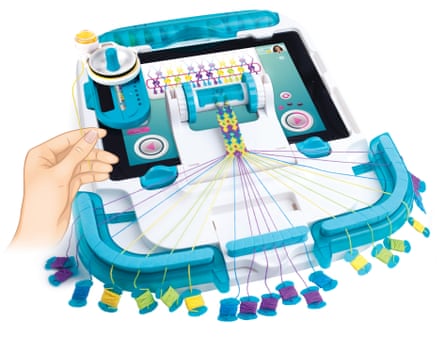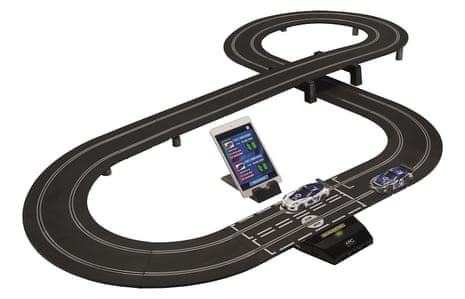An iPad loom for friendship bracelets, a wireless electronics kit you can activate with a tweet, and a hi-tech Scalextric race track you can play with via your smartphone.
These are just a few of the traditional toys that have undergone a technological makeover to appeal to “digital natives” – or “children” as they are known outside the booming £3bn toy industry. The new toys are being shown at the annual Toy Fair at Kensington Olympia in west London, which begins today.
“Kids today are exposed to technology from an early age and are just as enthralled by digital-driven products as their parents,” said John Baulch, publisher of Toy World magazine. “Integrating the latest technological developments into a toy is a way of delivering the experience children are looking for, and keeps toys contemporary and relevant.”
Such progress, however, comes at a price. To buy Hornby’s new Arc range of Scalextric race track – which connects to a “free” app on your child’s smartphone via Bluetooth – you will have to spend between £100 and £200, with a £500 version set to launch later this year. Needless to say, a smartphone is not included in the price.
“Parents are under increasing pressure to purchase their child some sort of smartphone or tablet just so they are able to use the toy they’ve asked for,” said Ben Redhead, head of buying at the online shop Firebox.com. “Manufacturers of these high-end connected toys also know that, with the ability to push regular new content to compatible apps and even the actual firmware of these toys, they can charge higher retail prices, due to the longevity that a more ‘traditional toy’ may not have.”
The original Scalextric, unveiled at the Harrogate Toy Fair in 1957, was made up of rubber tracks, metal racing cars and a rudimentary plastic and rubber circuit. Now the Scalextric app enables you to time your laps, share your results on social media and engage in what Hornby calls “additional gameplay”.
Baulch says toy companies are keen on such apps because of the creative possibilities they open up. “Adding an app can’t make a bad toy good, but if an app enhances the play value of a successful toy you get the perfect storm of creativity and imagination along with the added ‘cool factor’. It’s the best of both worlds.”
Another toy launching at the fair, run by the British Toy and Hobby Association (BTHA), is the i-Loom, a £29.99 bracelet kit targeted at 10- to 16-year-olds. The toy fits over an iPad, turning the tablet into a physical loom. Users download an app and follow the instructions on screen to thread the bracelet, according to designs they have either pre-selected or created themselves.

It is a sort of evolution of the loom band, the small rubber bands that are designed to be twisted into bracelets and which became a craze among children and young teenagers two years ago.
“We wanted to put an angle on bracelet-making that had never been done before,” said i-Loom spokesman David Williams. “The app enables our customers to learn high-quality bracelet-making very quickly and makes it easy for us to communicate new ideas and designs to them in the future. ”
The BTHA estimates around 15% of toys now rely on hi-tech software or apps to “enhance” their play, with a larger proportion of premium-priced toys making up this slice of the market.
“Traditional toys without any added technology are set to be among the bestsellers this year,” said Natasha Crookes, the director of communications. “However, the number of toys incorporating technology to enhance play is growing year-on-year, and will continue to do so.”
Even the new version of Monopoly includes a credit card machine that allows you to pay digitally, with a card reader. However, the more technology a toy contains, the higher the price tag is likely to be, says Gary Grant, managing director of toy retailer The Entertainer.
One example of this is Sam Labs’ electronics and code-building kit: a new type of circuit board you connect via Bluetooth (instead of with wires), using an intuitive, educational software interface on your computer. Budding inventors and coders can use it to learn engineering concepts and make anything from an internet-connected doorbell to a mini drum machine in minutes, but there’s a catch. The starter kit is £69, while the most comprehensive option is £550.
“It’s a valid investment because your child never grows out of it, you can progress from beginner to expert with the same equipment,” says founder Joachim Horn.
Cambridge Brainbox, a small toy company exhibiting at the fair, has been selling more traditional electronics kits for 15 years. These range from £13.99 for a basic circuit board aimed at five- to seven year-olds to £64.99 for an advanced model that enables you to build your own radio.
“We price our toys to be affordable for parents who want to spark a child’s interest in electronics,” says managing director Wazz Mughal. “It’s essential there are kits out there at lower prices so that all children can access knowledge about electronics. We need to impart that knowledge to the next generation, who are going to build our technology in the future.”

Comments (…)
Sign in or create your Guardian account to join the discussion